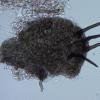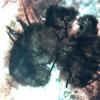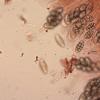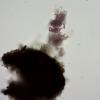
31-12-2025 19:27
Collected from loamy soil, at waterside (completel

30-12-2025 16:44
Pascal DucosBonjour,Une anamorphe rose stipitée, très nombre

30-12-2025 17:14
 Bernard CLESSE
Bernard CLESSE
Bonjour à toutes et tous,Pourriez-vous aider Albe

29-12-2025 10:15
Hulda Caroline HolteHello, I found and collected this propoloid ascom

30-12-2025 09:04
Hello.A Pyrenomycete sprouting sparsely but very d

29-12-2025 17:44
Isabelle CharissouBonjour,J'aimerais savoir si d'autres personnes au

12-11-2021 00:03
Lepista ZacariasHi everybody,A week ago in my fiels trip I noticed

On decorticated wood of Picea abies, I found several small globose pseudothecia of about 100µ with non-septate brown setae of 50x3µ. Tha clavate asci appeared bitunicate, and had 8 biseriate spores which were almost hyaline( 13x6µ)The dimensions of the asci were 70x17µ.Spores were muriform with 4 transversal septae and 3-4 longitudinal septae.No paraphyses were seen.
With the key of Friebes(2012) I came to Capronia chlorospora.The spores also matched with the pictures in The Handbook of Ascomycota of Wergen.
Unfortunately the asci didn't react red after using KOH nor blue with IKI after pretreatment with KOH. Does this mean that I have to look in another genus?

Hello Marc,
perhaps you should use the IKI without pretreatment with KOH.
As far as I know all hemiamyloid reactions do not work with KOH.
Best regards, Lothar

Not all Capronia species react heimamyloid, some are negative.
Your second photo shows a blue colour in the middle part, is it in KOH+IKI?
The red hemiamyloid reaction is ONLY obtained without using KOH, as Lothar correctly says. After KOH-treatment and washing with water IKI gives a blue reaction, and in taxa with indistinct hemiamyloid reaction like Capronia it is recommended to test both, IKI without KOH, and pretreatment with KOH, because the blue reaction is always easier to see than the red reaction.
Zotto


Thanks Zotto.
Do you still think it's a Capronia?







